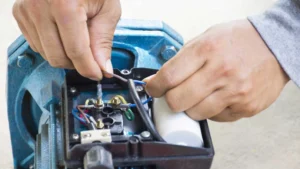Troubleshooting Bell & Gossett pumps in automotive environments presents unique challenges that require a methodical approach. Understanding the common issues these pumps face, such as leaks or performance inefficiencies, is essential for effective maintenance. By employing diagnostic tools and adhering to best practices, one can greatly enhance the reliability of these systems. However, the intricacies involved in identifying and resolving these problems often go beyond basic troubleshooting. Exploring the most effective techniques and maintenance practices can illuminate pathways to improved performance and longevity. What critical insights can transform your approach to these indispensable automotive components?
Key Takeaways
- Perform a visual inspection for leaks, unusual noises, and signs of wear to identify potential issues early.
- Utilize pressure gauges and flow meters to assess pump performance and diagnose operational problems.
- Check electrical connections and control systems for reliability, especially during intermittent performance failures.
- Monitor fluid levels regularly to prevent cavitation and ensure the pump operates efficiently.
- Document all findings and seek professional help if unusual vibrations or persistent issues arise.
Understanding Bell & Gossett Pumps
Understanding Bell & Gossett Pumps requires a detailed examination of their design, functionality, and application within various systems. These pumps are engineered for efficiency in moving fluids, primarily in heating, cooling, and water circulation applications. The design features a robust construction that includes high-quality materials, ensuring durability under diverse operational conditions.
The functionality of Bell & Gossett pumps is centered around their ability to create a pressure differential, allowing the movement of fluids through piping systems. They commonly employ centrifugal force, making them suitable for a variety of automotive applications where reliable fluid transport is critical. The pumps are available in various configurations, including inline and submersible models, catering to specific installation requirements.
In automotive environments, the integration of these pumps necessitates an understanding of their performance metrics, such as flow rate, head pressure, and energy consumption. By thoroughly understanding these parameters, technicians can optimize the selection and maintenance of Bell & Gossett pumps, ensuring peak operational efficiency. This knowledge fosters a sense of belonging among professionals who utilize these pumps, as they can confidently troubleshoot and enhance system performance within their respective fields.
Common Issues in Automotive Use
In automotive applications, Bell & Gossett pumps may encounter several common issues that can affect their performance and reliability. One prevalent issue is cavitation, which occurs when the pressure within the pump drops below the vapor pressure of the fluid, leading to the formation of vapor bubbles. These bubbles can collapse violently, causing damage to pump components and reducing efficiency.
Another common concern is improper alignment. Misalignment can lead to increased wear on bearings and seals, resulting in premature failure. It is essential to guarantee that the pump is aligned correctly with the motor and piping to maintain ideal operation.
Additionally, contamination of the pump fluid can pose significant problems. Particulate matter or corrosive substances can cause wear and tear on internal components, leading to leaks or outright failure. Regular fluid analysis and filtration can mitigate these risks.
Lastly, overheating is an issue often encountered in automotive environments, particularly when pumps are subjected to high ambient temperatures or insufficient cooling. Monitoring operating temperatures and implementing appropriate cooling measures are fundamental for maintaining pump integrity. Addressing these common issues is critical for effective troubleshooting of Bell & Gossett pumps in automotive settings.
Effective Troubleshooting Techniques
Employing systematic troubleshooting techniques is essential for diagnosing and resolving issues with Bell & Gossett pumps in automotive environments. A structured approach begins with a thorough visual inspection, checking for leaks, unusual noises, and signs of wear. This initial assessment can reveal obvious problems that require immediate attention.
Next, utilize diagnostic tools such as pressure gauges and flow meters to measure performance metrics. Comparing these readings against the manufacturer’s specifications is critical in identifying deviations indicative of underlying issues. When troubleshooting Bell & Gossett pumps, pay close attention to electrical connections and control systems, as intermittent failures here can lead to operational disruptions.
Documenting findings during each step of the troubleshooting process facilitates a detailed analysis and aids in identifying recurring problems. Additionally, engaging with technical manuals and online resources can provide valuable insights into specific pump models and their common failure points.
Finally, verify that all personnel involved in troubleshooting are equipped with the necessary training and knowledge to execute these techniques effectively. By fostering a collaborative environment, organizations can enhance the troubleshooting process, ultimately leading to improved pump reliability and efficiency in automotive settings.
Maintenance Practices for Longevity
Regular maintenance practices are essential for ensuring the longevity and optimal performance of Bell & Gossett pumps in automotive environments. To maintain peak functionality, routine inspections should be conducted to identify any signs of wear or damage. This includes checking seals, bearings, and impellers for signs of deterioration, which can lead to inefficiencies and potential failure.
Furthermore, regular lubrication is critical, as it prevents friction and overheating, thereby extending the lifespan of pump components. Utilize manufacturer-recommended lubricants and adhere to specified intervals for application. Additionally, monitoring fluid levels and ensuring they are within acceptable ranges is crucial for pump operation; low fluid levels can cause cavitation and damage.
Another important aspect of maintenance is the monitoring of vibration and noise levels. Any significant deviations from normal operating conditions may indicate underlying issues that require immediate attention. Finally, maintaining a clean environment around the pump can reduce the risk of contamination, which can impair functionality.

When to Seek Professional Help
Even with diligent maintenance practices in place, there are circumstances where issues may arise that require expertise beyond routine care. Recognizing the limits of in-house troubleshooting is essential for the longevity and efficiency of Bell & Gossett pumps. Specific symptoms, such as unusual vibrations, persistent leaks, or atypical noise patterns, often indicate underlying mechanical or electrical issues that necessitate professional intervention.
When troubleshooting Bell & Gossett pumps, if basic diagnostic efforts fail to yield results, it is prudent to consult with certified technicians. These professionals possess specialized knowledge of pump systems and can utilize advanced diagnostic tools to accurately identify and rectify complex problems. Furthermore, if there are ongoing performance issues impacting system efficiency or reliability, seeking expert assistance can prevent further deterioration and potentially catastrophic failures.
Additionally, if your team lacks the necessary training or resources to perform thorough assessments, the risks of improper handling increase considerably. In such instances, prioritizing safety and operational integrity by involving professionals is critical. Ultimately, recognizing when to seek assistance not only preserves the investment in your equipment but also fosters a culture of accountability and precision within your automotive environment.
Frequently Asked Questions
What Are the Benefits of Using Bell & Gossett Pumps in Automotive Applications?
Bell & Gossett pumps offer high efficiency, robust design, and reliable performance in automotive applications. Their innovative technology enhances fluid management, reduces maintenance, and guarantees peak system operation, contributing to improved productivity and longevity in automotive environments.
How Can I Identify the Model of My Bell & Gossett Pump?
To identify the model of your Bell & Gossett pump, examine the nameplate for model numbers, serial numbers, and specifications. Cross-reference this information with manufacturer documentation or their website for accurate identification and support.
Are Replacement Parts Readily Available for Bell & Gossett Pumps?
Replacement parts for Bell & Gossett pumps are generally readily available through authorized distributors and manufacturers. Ensuring compatibility with specific models is vital for ideal performance and longevity in various applications, including automotive environments.
Can I Use Bell & Gossett Pumps in Extreme Temperatures?
Bell & Gossett pumps can operate in extreme temperatures; however, specific models may have limitations. It is vital to consult manufacturer specifications to guarantee peak performance and longevity under such conditions, emphasizing proper application in extreme environments.
What Warranty Options Are Available for Bell & Gossett Pumps?
Bell & Gossett offers various warranty options, typically ranging from one to five years, depending on the pump model. It is advisable to consult specific product documentation for detailed warranty terms and conditions applicable to your purchase.
Conclusion
In conclusion, effective troubleshooting of Bell & Gossett pumps in automotive environments necessitates a systematic approach encompassing visual inspections, performance assessment, and careful evaluation of electrical systems. Identifying common issues and applying best maintenance practices greatly enhances pump longevity and reliability. Should persistent problems arise despite thorough troubleshooting efforts, seeking professional assistance is advisable to guarantee peak functionality and prevent further complications. Adherence to these guidelines will facilitate improved operational performance in automotive applications.
You May Also Like To Read:
